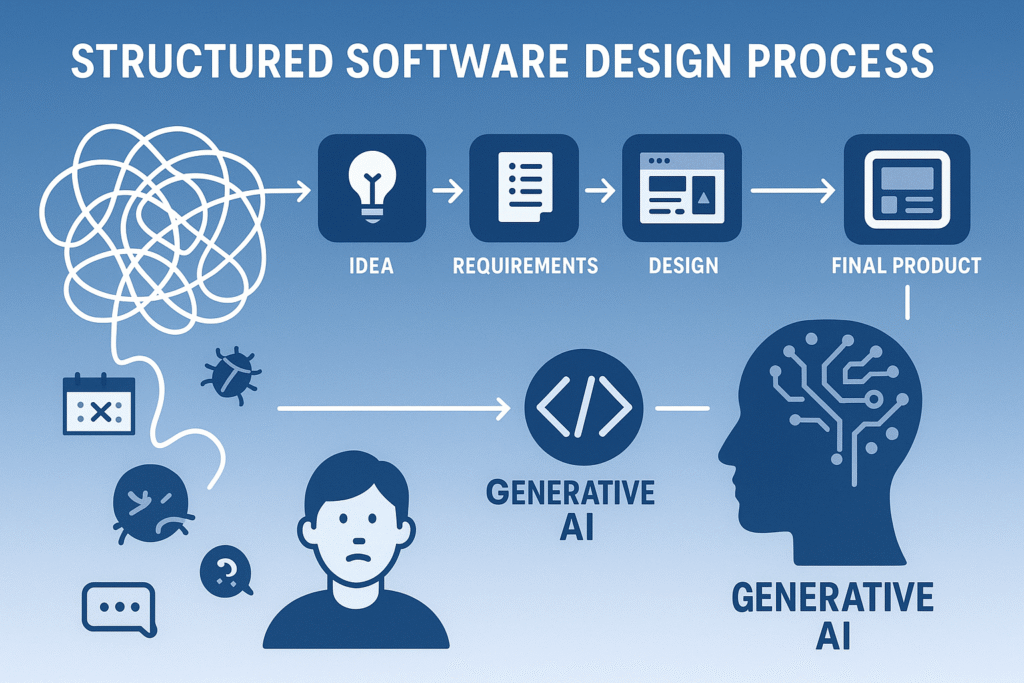When your team embarks on building an app, what do you focus on first? The features? The code? Or the layout?
Before diving in, it’s crucial to understand the software design process. Why? Because skipping this essential foundation often leads to chaos—missed deadlines, mounting bugs, and frustrated users. Without a structured design approach, teams lose direction. The software design process acts as the vital bridge between an initial idea and a successful, functional product.
By 2024, around 30% of organizations were already using generative AI in software and IT. This isn’t a passing trend anymore. Teams are seeing real results. But even with advanced tools, a structured process is still crucial. If the blueprint is flawed, the final product will be too.
Turn Your Idea into a Winning Product with the Right Design Process
So, what’s the software design process? It’s a method that turns an idea into a working product, step by step. It’s where user needs meet technical logic. Think of it as a roadmap that guides the team from concept to code.

At its core, the software design process applies fundamental design concepts. These aren’t just theoretical ideas, but essential rules that make software stable, scalable, and user-friendly. Factors like user focus, performance, and maintainability aren’t optional—they’re foundational. Without them, your app will either crash or confuse users.
And this isn’t just a guess. Take JPMorgan Chase, for example. After integrating an AI coding assistant, they saw a 10% to 20% improvement in engineering efficiency. That didn’t happen by chance. It was the result of a deliberate design-first approach. They structured the process and empowered their engineers with smart design decisions and tools that supported their system.
Why Process Matters
Without a design process in software engineering, you risk endless revisions, wasted time, and an unfinished product. The worst outcome? Handing users something they don’t need or can’t use.
Smart teams avoid this by adhering to the software engineering design process every time.
Building from Scratch or Buying Pre-Made Solutions?
Choosing between custom software development and buying off-the-shelf solutions affects every phase of the software design process. Comparing the pros and cons of each can help you determine which option aligns with your project goals.
Tools Supporting Software Development and Design
Now, let’s look at the tools that help make this process work.
- Wireframing tools like Figma or Balsamiq help teams map out layouts and structure.
- Architecture tools like Lucidchart or Draw.io define the backend logic.
- Code collaboration platforms like GitHub or GitLab make version control and team collaboration smooth.
- AI-driven IDEs assist with code generation, speeding up the process while ensuring consistency.
These aren’t just fancy tools. They’re essential parts of the software design process, saving time, reducing errors, and fostering teamwork. Skipping these tools or jumping straight into coding without planning will only lead to missed opportunities to spot issues early.
Whether you’re building a startup MVP or redesigning an enterprise system, this process is applicable to every project. It brings structure where it’s needed most.
Designing Great Software: More Than Just an In-House Team
Great software often requires more than just an in-house team. Many companies expand their reach by bringing in external expertise, speeding up timelines, and enhancing the project’s overall quality.
The Five Stages of Software Design
Every project is unique, but the best teams follow a structured path. These aren’t mere habits—they’re steps in the software design process that turn scattered ideas into functional systems.
Even in 2024, AI assists with coding, but no AI will build success without human guidance. And that guidance starts with these five stages.
- Spark It: The Big Idea
- What Happens: This is the beginning. The goal is simple: Understand the app’s purpose. Who needs it? What problem does it solve? This is where the software design process begins with clarity.
- Why It Matters: We’ve seen teams waste weeks chasing the wrong idea. Laying this groundwork early prevents waste and ensures business goals align with technical execution.
- Map It: The Game Plan
- What Happens: Now, features and workflows are planned. This includes the interface, logic, and screens. Think user journeys, system diagrams, and wireframes—everything that defines how the product will function.
- Why It Matters: Scope creep is a major project killer. A solid map sets boundaries and helps teams stay focused on what’s needed, avoiding unnecessary additions during the build.
- Style It: The Vibe
- What Happens: This stage brings visuals to life. It involves designing the UX/UI, including colors, buttons, layouts, and feedback messages.
- Why It Matters: Appearance matters. A beautiful interface helps users trust and engage with your app. Even the most powerful back-end won’t succeed if the front-end is confusing.
- Code It: The Build
- What Happens: Now, the real work begins—writing the frontend, backend, APIs, and data structures. This is where the plan transitions into working code, following best practices.
- Why It Matters: With strong planning in place, the coding phase is much smoother and faster. Developers know exactly what to build, reducing unnecessary back-and-forth.
- Perfect It: The Shine
- What Happens: This phase involves testing, refining, and squashing bugs. The product is checked for speed, accuracy, security, and compatibility.
- Why It Matters: No one wants a product launch filled with issues. This stage catches hidden problems before they affect users and ensures a polished final product.
Six Core Software Design Principles
To build software that lasts and adapts, you need more than just code. These six principles form the backbone of solid software architecture:
- Modularity: Break software into smaller, manageable sections (modules). Each module handles a distinct function. This simplifies maintenance and collaboration.
- Coupling: Low coupling means modules are less reliant on each other. This reduces the risk of cascading failures if one part breaks.
- Abstraction: Simplify complexity. Hide unnecessary details from the user or developer. This makes the code easier to maintain and understand.
- Anticipation of Change: Design software with flexibility in mind. This allows for easy updates and scalability as the system evolves.
- Simplicity: Avoid unnecessary complexity. Focus on solving the problem with minimal effort and resources.
- Sufficiency & Completeness: Build features only when needed. Ensure the design is complete but doesn’t include unnecessary functions.
Applying Principles to the Design Process
When these principles are followed, the result is a stable and adaptable software product. Ignoring them leads to systems that are hard to maintain, prone to failure, and difficult to upgrade.
| Principle | If Ignored | If Applied Well |
|---|---|---|
| Modularity | Code changes break unrelated features | Easy maintenance and collaboration |
| Coupling | One error causes system-wide failure | Isolated issues, faster fixes |
| Abstraction | Everyone touches everything | Clean interfaces, fewer accidents |
| Anticipation of Change | Hard to upgrade or scale | Easy updates and future-proof builds |
| Simplicity | Complex workflows slow teams | Clear logic, better onboarding |
| Sufficiency & Completeness | Missing or bloated features | Focused functionality, better user experience |
Why the Software Design Process Works
The software design process leads to apps that run reliably and meet user needs. With structured steps, teams can:
- Deliver functional apps: Poor design leads to bugs, crashes, and user abandonment. Structured design ensures reliability.
- Launch faster: By minimizing errors and keeping the scope clear, the project reaches the finish line quicker.
- Reduce rework: Clear documentation prevents rewriting large sections of the code.
- Meet user needs: By starting with user requirements, teams deliver products users actually want.
The Future: 2025 and Beyond
In today’s fast-paced environment, the software design process must be agile, flexible, and efficient. Trends like cloud flexibility, low-code platforms, and AI integration are reshaping the industry. Teams that adapt to these changes and maintain a strong design process will remain competitive.
Wrap-Up: Start Your Success with Strong Design
The best teams understand that a structured software design process is essential for delivering products that work, scale, and meet user needs. The journey from concept to launch may seem long, but with the right planning and process, it leads to success.
In 2025, software won’t just be about more apps—it’ll be about better apps. And the key to creating them is a structured design process that works.
